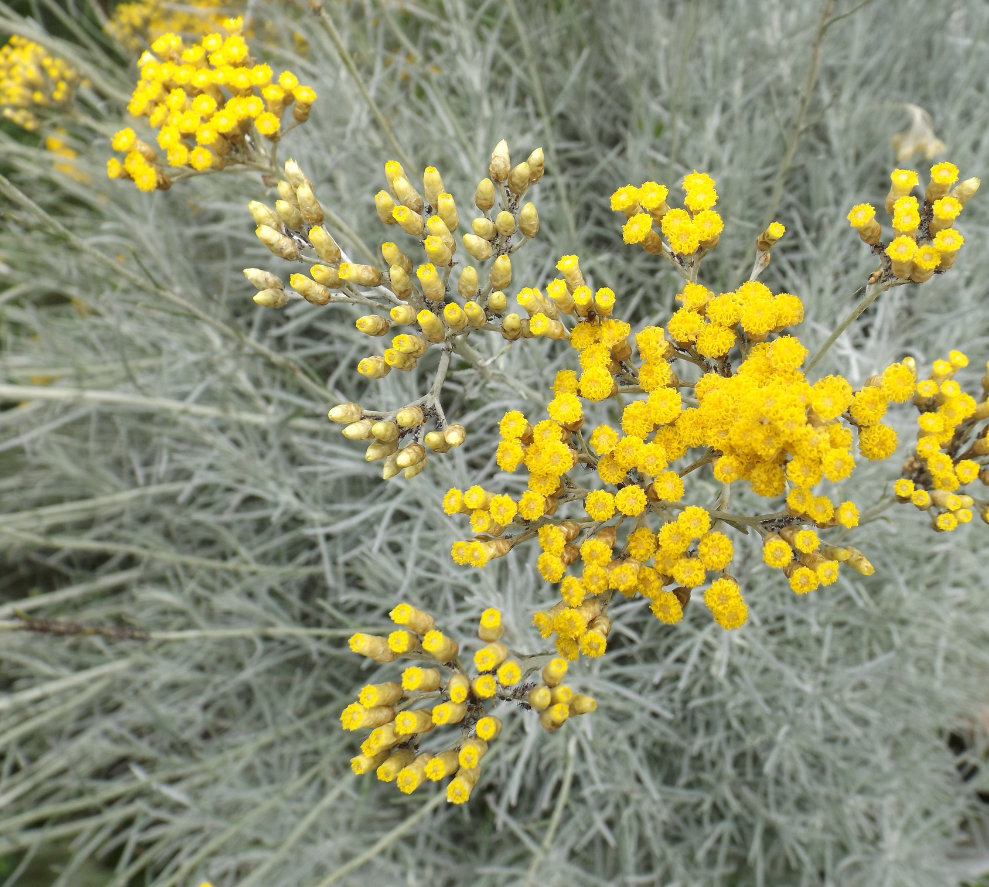

CURRY PLANT
Helichrysum italicum
No. You can't eat it. Do not add to curries!
The Curry Plant smells like a curry though. It has silvery foliage and grows to about knee height, favouring dry and rocky ground.
It flowers prolifically with round yellow flowers and looks particularly good in native gardens with its spiky silver leaves and contrast to dark foliage.
We like to prune ours hard to the ground to keep the bush dense and flowers en masse.
Let us know if your curry plant attracts bees – some bee species seem to love it while others ignore it.
PRICE: $6.00
SIZE: 5cm radius seedling
Curry Plant
Helichrysum italicum
Australian History
The Curry Plant, or Helichrysum italicum, is a native of the Mediterranean region but has found a cosy home in Australian gardens. It's a hardy evergreen perennial, famous for its aromatic, curry-scented foliage, which might remind you of your favourite Indian dish. Although it's not actually used in curry recipes, it has become a popular ornamental plant in Aussie gardens, thanks to its unique fragrance and attractive silver-grey foliage.
Australian Uses
While the Curry Plant isn't typically used for cooking curries, its leaves can still add a subtle flavour to your dishes. You can use the fresh or dried leaves to infuse oils or vinegars, or simply toss a few sprigs into a pot of soup or stew to add an interesting twist. The Curry Plant also has a history of traditional medicinal uses, such as treating minor burns, inflammation, and skin irritations. And, of course, it's a fantastic ornamental plant that adds a touch of the Mediterranean to your Aussie garden.
Australian Growing Guide
Ready to grow some Curry Plant in your garden? Here's how! This hardy plant loves well-drained soil and a sunny spot, so find a nice, bright location for it. Plant it in the spring or autumn, giving each plant a good 30-45 centimetres of space. You'll find that the Curry Plant is quite drought-tolerant, so don't worry too much about watering. Just give it a drink when the soil feels dry to the touch. Prune it lightly after flowering to keep it looking neat and bushy, and watch out for frost in colder regions – the Curry Plant isn't a big fan of freezing temperatures.
Australian Landscaping
The Curry Plant makes a brilliant addition to your Australian landscape, whether you're going for a Mediterranean vibe or just want something unique. Its silvery-grey foliage and bright yellow flowers create a stunning contrast against other plants. Try pairing it with Rosemary, Lavender, or Santolina for a delightful mix of colours, textures, and scents. The Curry Plant also works great in rock gardens, coastal gardens, or even as a border plant. Its drought-tolerant nature makes it a top choice for xeriscaping, too!
Australian Companion Plants
TThe Curry Plant plays well with others. Its strong scent can help deter pests like aphids, whiteflies, and cabbage moths, making it a fab companion for Brassica veggies, such as cabbage, broccoli, and kale. The Curry Plant also gets along well with other Mediterranean herbs, like Thyme and Oregano, which share similar growing conditions. Additionally, planting Curry Plant near legumes, like peas and beans, can be beneficial, as these plants help fix nitrogen in the soil, providing essential nutrients for your Curry Plant and other nearby plants.
Australian Disease Resistance
When it comes to diseases, the Curry Plant is a bit of a champ. It's generally resistant to most common diseases, as long as you give it the right growing conditions. However, it can still be affected by root rot if over-watered or planted in poorly drained soil. To avoid this, make sure your Curry Plant gets plenty of sunlight and well-draining soil. Keep an eye on your plant for any signs of disease, and remove any affected parts promptly to prevent further issues. Follow these tips, and you'll have a healthy, happy Curry Plant in your Aussie garden!
